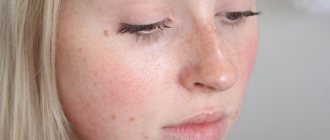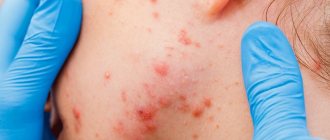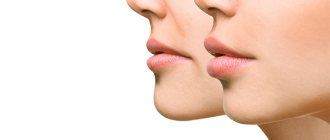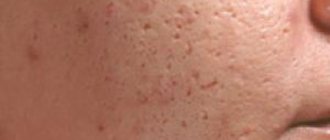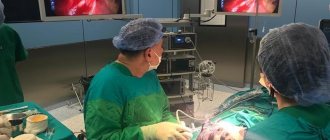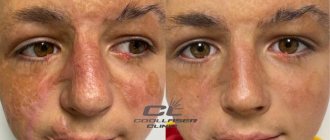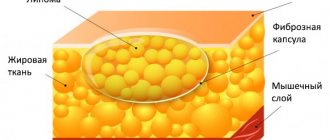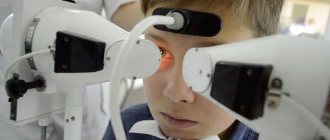- What is inside a pimple, full answer
- What's inside black and white pimples?
- What is inside a pimple, papules and pustules?
- What is inside pimple cysts and nodules?
Pimples inside under the skin contain oil, acne bacteria, dead skin cells and white blood cells. A pimple appears when sebum, an oily substance produced by the skin, gets into the pores. Bacteria begin to replicate in this sebum, leading to the formation of pimples.
What is inside a pimple, full answer
There are several different types of pimples. Black heads on a pimple form when a pore is left open and the sebum is exposed to air, which turns it into a dark color. These pimples form when sebum gets trapped under the surface of the skin but remains inside the pore.
Large inflammatory acne lesions can form when acne bacteria become inflamed within the pores, allowing the contents of the pimples to leak into the surrounding tissue. When this happens, large numbers of white blood cells rush into the area of inflammation to fight off the bacteria, often leading to the formation of large amounts of pus under the skin inside. A variety of acne lesions are initially known as a papule, which develops a large white head on the surface of the skin of the body or face.
Very large inflammatory acne lesions that are often associated with multiple pore lesions are called cysts. The cyst usually contains a large amount of pus inside the pimple.
"Eternal" pimple
Natalya Sokolova, head of the clinic of the Akmola Regional Dermatovenerological Dispensary, told the Good Health magazine about how to distinguish a wen from a pimple and how to get rid of it.
The accumulation of sebum can be called differently - a sebaceous cyst, a lipoma, but the popular definition of “fat” is most often used. In any case, this is a formation in which fat accumulates.
“A person can diagnose it himself - most often wen appear on the face, back, hands, hips, legs,” says Natalya Evgenievna. – Often a wen passes itself off as an ordinary subcutaneous pimple. But the difference is that the pimple goes away, but the wen does not. If you press on it, nothing hurts - it may even be soft to the touch.
Wen can reach a diameter of 5 cm. Of course, if a person has “grown” it to this size, he needs to see a doctor.
– Why do they appear on the body?
– There are several versions. The ducts of the sebaceous gland can become clogged and clogged, causing a fat capsule to form in this area over time. We also noticed that wen appears in an area where the number of fat cells increases. There is also a version that due to diet, fat thickens, is difficult to excrete and remains under the skin.
– Is there a category of people who most often encounter lipoma?
– No, wen appears in both men and women, adults and even children. By the way, children under five years old should not remove it.
– Should I worry if a wen appears on my body?
– In most cases, there is no cause for concern, unless the wen is gigantic in size. And yet, a person must understand that a wen is a benign skin tumor. If it hurts or begins to grow rapidly, then you need to see a doctor.
– Is it possible to squeeze out a wen?
– It is not advisable to squeeze out. Microbes that are in the closed cavity of the cyst, when ruptured, end up on healthy skin, which is not good. Moreover, if it bursts inside, it can even lead to sepsis.
– What methods can you use to get rid of wen? Or will the person have to live with him until the end of his days?
– Before starting treatment, the doctor must make sure that it is definitely a wen. Ultrasound examination will help him with this. A biopsy will also need to be done.
If the lipoma is small, you can inject a substance into the wen that will absorb the fat. If the doctor sees that the wen is growing, especially on the head, in the eye area, or spoils the patient’s appearance, he may suggest a surgical method. I must warn you that after such treatment scars remain on the body. You can also “pump out” this wen using a puncture, but this method is not suitable in all cases. Modern medicine also offers laser removal of the wen - it is easier to tolerate than surgery and does not leave any traces. It is very important, after removing a lipoma, to send its contents for histology to make sure that it is not a malignant tumor.
– Do wen come back?
– If the fat was not completely pumped out, then the wen will probably fill with fat again.
– Many people believe that they can get rid of lipoma with the help of traditional medicine. Is it true?
– Many people make some kind of compresses, rub the wen, drink decoctions, and even try to lose weight in the hope that the fat will resolve. I have to disappoint adherents of traditional medicine that their methods practically do not work.
– Can a person take any measures to protect against wen?
– It is within his power to maintain hygiene and prevent injury to the skin. Of course, you should watch your diet
What's inside black and white pimples?
Poll: When did your acne appear? (Number of votes: 4295)
I've been suffering all my life
It's been a couple of years now
About a few months
Recently
To vote, click on the desired answer. results
What's inside black and white pimples?
Black and white pimples are clogged inside with the same dead skin cells (which your skin always produces when exposed to acne bacteria) form on the skin, and sebum (an oily substance secreted by tiny glands) is found inside your pores.
Many people think that black pimples are clogged with dirt inside, but that's not true. The difference in color between these two types of pimples is actually due to the effects of oxygen, as the National Institutes of Health explains.
In whiteheads, the blockage is below the surface of the skin and therefore remains white. But in blackheads, the seal opens when exposed to air. It turns brownish-black when they are exposed to oxygen.
Acne marks
Post-acne is the unpleasant marks that acne can leave behind: lumps and scars, changes in skin color in certain areas, red spots from acne, enlarged skin pores, the appearance of a vascular pattern (rosacea), sometimes even deep scars. Dermatologists combine all these skin changes under the term post-acne (“post” - after, “acne” - pimples, blackheads). The more severe the acne disease, the more pronounced the signs of post-acne will be. Even after non-acute, but long-term processes, quite noticeable scars and depressions can remain. The main reasons for the occurrence of post-acne are improper treatment or lack thereof during the period of skin lesions with acne, mechanical removal of contents, lack of proper facial skin care, and also if the patient did not turn to specialists for help and did not use specially selected treatment products, then the likelihood of that scars and spots form after acne increases several times. If the form of acne is severe, the rashes are deep, for example cysts, nodules, then during healing there will always be scars, so it is very important to start proper acne treatment on time so that as few such forms of acne form as possible.
The most common acne marks are:
- Scars . Acne scars usually remain after inflammatory processes that affected the deep layers of the skin and were accompanied by abundant formation of pus, with long-term difficulty in the release of pus from the inflamed area to the surface of the skin. In this case, the inflammatory reaction develops for quite a long time in a confined space, gradually spreads to nearby areas of the skin and ultimately seriously deforms them. Often the cause of scars is inept attempts to squeeze out pimples, resulting in deep skin damage that heals with the formation of a scar (most often atrophic). The color of acne scars changes over time: from the pink color of fresh scars to the color of normal skin about a year after appearance, but can also become hyperpigmented or, conversely, paler than the base color of the skin.
The following types of acne scars are known:
Atrophic scars - resemble a small rectangular or oval hole, the color of which is usually flesh-colored. This type is divided into rounded, chipped and rectangular scars.
Physiological scars are almost completely invisible on the skin and heal quite quickly.
Keloid scars - cause itching and other painful sensations, similar to hypertrophic scars. They form quite rarely on the surface of the face.
Hypertrophic scars are convex, pink, dense formations. They arise due to a huge amount of scar tissue.
- Vascular spots. Prolonged inflammation of the skin leads to disruption of blood microcirculation in these areas. An additional factor in their appearance is crude attempts to squeeze or open pimples. As a result, areas of burgundy, crimson, and bluish redness may appear. Without treatment, these acne spots can remain on the skin for a long time (sometimes more than a year). It is also possible that telangiectasia (visible vascular networks on the surface of the skin) may appear, which do not tend to go away on their own.
- Changes in skin pigmentation - dyschromia. Dyschromia is a disorder of skin color. With dark skin, acne marks may appear as light spots against the background of dark skin. With fair skin, dark spots appear at the sites of resolved rashes. The immediate causes of changes in skin pigmentation are prolonged inflammation and trauma to the skin due to inept attempts to squeeze out or open pimples. Areas of dyschromia can appear both under the influence of ultraviolet radiation and without it.
Registration for consultation
Post-acne treatment methods:
- Chemical peels - various acids are used to dissolve the stratum corneum of the epithelium. As a result, increased division of young cells begins and, as a result, the upper layer of the skin is leveled. With their help, you can make the transition of the surrounding skin into an atrophic, receding scar less noticeable or make a hypertrophic, protruding scar flatter. Peels are most effective on fresh acne scars (pink in color).
- Mesotherapy is a fairly effective modern method that allows you to saturate the skin with the most necessary substances and microelements. Its principle is to introduce into the skin compositions that include biologically active substances, vitamins, hyaluronic acid and various enzymes. For different types of scars and different stages of their growth, different drugs are used.
- Biorevitalization – hyaluronic acid is very important for proper skin healing. The use of biorevitalization in the early stages of scar formation allows you to avoid the formation of coarse scar tissue.
- Laser skin resurfacing allows you to minimize the effects of acne over several procedures. The method involves gently removing the upper keratinized layer; the laser also activates all biochemical processes, including the production of collagen, which provides the necessary elasticity of the skin. The doctor determines the number of required sessions individually for each patient. Their number depends on the condition of the skin and the presence of spots.
- Pulse light therapy - has a bactericidal effect, reduces inflammation, reduces the activity of the sebaceous glands, reduces redness (acts on small capillaries), stimulates the production of collagen fibers (scars become less noticeable). Used to treat if there are red spots from acne and red acne scars. The doctor also determines the number of required sessions individually for each patient.
It is important to remember that when choosing any method of combating post-acne and other consequences of acne, you must first consult a doctor, since only a dermatologist will be able to assess the degree and depth of post-acne, and prescribe not only an effective, but also an adequate method of treatment.
Prevention
Prevention of post-acne involves preventing exacerbations of acne and timely professional treatment of acne, preventing the appearance of deep purulent inflammations. And also in careful handling of inflamed areas and proper skin care. It is necessary to refrain from independently attempting to squeeze or otherwise open pimples. In most cases, it is precisely such attempts that aggravate the situation and lead to the formation of a scar at the site of the pimple, since when trying to squeeze out a pimple, its contents may rush not to the surface of the skin, but, on the contrary, into the depths and create a new focus of inflammation there, which will be much more difficult cure without scar formation.
What is inside a pimple, papules and pustules?
What is inside a pimple, papules and pustules?
Sometimes clogged pores become so irritated that their walls break down, and the body sends out white blood cells—your immune system's warriors—to begin repairing the damage caused by the pimple. As a side effect, the skin becomes red, painful, and inflamed.
This is when you may get pimples called papules or pustules. Papules are covered with red bumps that are hard and sometimes painful to the touch. Pustules are red and inflamed pimples with a white head in the center. These pimples contain pus inside and also contain dead white blood cells. cells.
Causes and mechanisms
The skin of the face is quite sensitive to external irritants that it has to deal with every day. It also changes under the influence of internal factors - metabolic changes and diseases. In addition, each person’s skin has its own structural characteristics and functions, fixed at the genetic level, and can react differently to negative influences. If a person experiences acne on his face, then the following conditions are likely among the causes:
- Acne disease (acne).
- Milia (“millet”).
- Pyoderma (staphylo and streptococcal).
- Simple herpes.
- Allergic diathesis.
- Demodecosis.
Of course, there are other diseases that manifest as a rash on the face. Among infectious pathologies, one cannot fail to note chickenpox, measles, rubella and scarlet fever. Dermatologists know cases of eczema, pemphigus and other skin lesions of a microbial, allergic and occupational nature.
There are quite a few factors that can lead to the appearance of rashes on the face. If you combine the probable preconditions for the development of acne, you get an impressive list. In addition to germs and mites that attack the skin, it includes:
- Neglect of personal hygiene rules.
- Excessive sebum production.
- Hormonal changes in the body (puberty, pregnancy, menstruation).
- Contact with chemicals, excessive sun exposure.
- Inappropriate cosmetics.
- Dietary errors.
- Problems with the gastrointestinal tract.
- Stressful situations.
- Taking certain medications, etc.
As you can see, acne on the face can appear for various reasons. The multiplicity of origins of the pathology makes it difficult in diagnostic terms, because it is necessary to take into account every factor influencing the condition of the skin. But an experienced doctor will always understand what is happening.
The causes of a rash on the skin of the face are the adverse effects of external or internal factors.
Symptoms of carbuncle
Clinical signs of a carbuncle are:
- suppuration and wound formation;
- hyperemia of the skin around the lesion;
- severe pain in the entire affected area.
The appearance and development of a carbuncle is usually accompanied by the following symptoms:
- elevated temperature, which often reaches 40 degrees;
- major intoxication;
- vomiting;
- nausea;
- loss of appetite;
- headache;
- general malaise.
These signs are especially pronounced when the carbuncle appears on the face or neck.
There are 3 stages of carbuncle:
Stage 1: infiltrate (folliculitis)
During this period, nodes form under the skin, which will be represented by inflamed hair follicles. The infiltrate contains adipose tissue, pus, lymph and lymphocytes. Nodules rise above the surface of the skin.
Since the nutrition of the dermis is disrupted, it acquires a bluish color. After a few days (from 9 to 12), the infiltrate reaches impressive sizes. It can be about 10 cm in diameter. The skin is swollen, tense, and hot to the touch. The more swelling there is, the more intense the pain will be.
Stage 2: purulent formation
At the stage of suppuration, the carbuncle reaches maturity. Blisters form on it, which are filled with pus. They open, so the surface of the carbuncle resembles a sieve. Through these small holes, pus leaks out, mixed with blood and dead epithelium.
The suppuration stage lasts about 14-21 days. During this period, the patient’s general health deteriorates.
Stage 3: necrosis and tissue rejection
During this period, pus from the carbuncle stops oozing. At the site of inflammation, ulcers are formed that will have rods. They merge with each other, forming one large defect. Tissue damage is very intense and often involves muscles. The affected area is black.
The wound heals slowly, gradually filling with granulations. A scar remains in its place. The necrosis stage lasts about 21 days.
Treatment methods for carbuncle
Small carbuncles that occur without noticeable intoxication and deterioration of the patient’s general condition are treated on an outpatient basis.
In cases where
- the patient is severely intoxicated,
- the carbuncle is large and localized on the face,
- the patient suffers from uncompensated diabetes mellitus or other serious diseases,
treatment is carried out in a hospital.
Conservative treatment
If treatment of the carbuncle was started at the stage of its maturation, then conservative methods are used, which in most cases leads to regression of the disease, that is, resorption of the infiltrate.
Antibacterial drugs with a broad spectrum of action are indicated for oral administration to the patient.
At the same time, the carbuncle itself is injected with antibiotics. To reduce pain, analgesics (Novocaine, Lidocaine) are used.
The surface of the carbuncle is treated with ethyl alcohol or other alcohol-containing antiseptics. An aseptic dressing is applied. Syntomycin or streptomycin emulsions are also used.
Surgery
If the carbuncle enters the necrotic stage, then this is an indication for surgery, which is performed while using antibiotic therapy.
The operation consists of dissecting the carbuncle and removing necrotic tissue from it.
Then a tampon with a hypertonic sodium chloride solution and proteolytic enzymes is inserted into the wound.
To clean the postoperative wound and completely remove necrotic tissue, the dressing is changed daily.
Physiotherapy
At the maturation stage, as well as in the postoperative period, UHF therapy and local ultraviolet radiation are prescribed.
To stimulate the body's defenses, intravenous laser and ultraviolet irradiation of blood can also be performed.
More information about the treatment method
Make an appointment Do not self-medicate. Contact our specialists who will correctly diagnose and prescribe treatment.
Rate how useful the material was
thank you for rating
